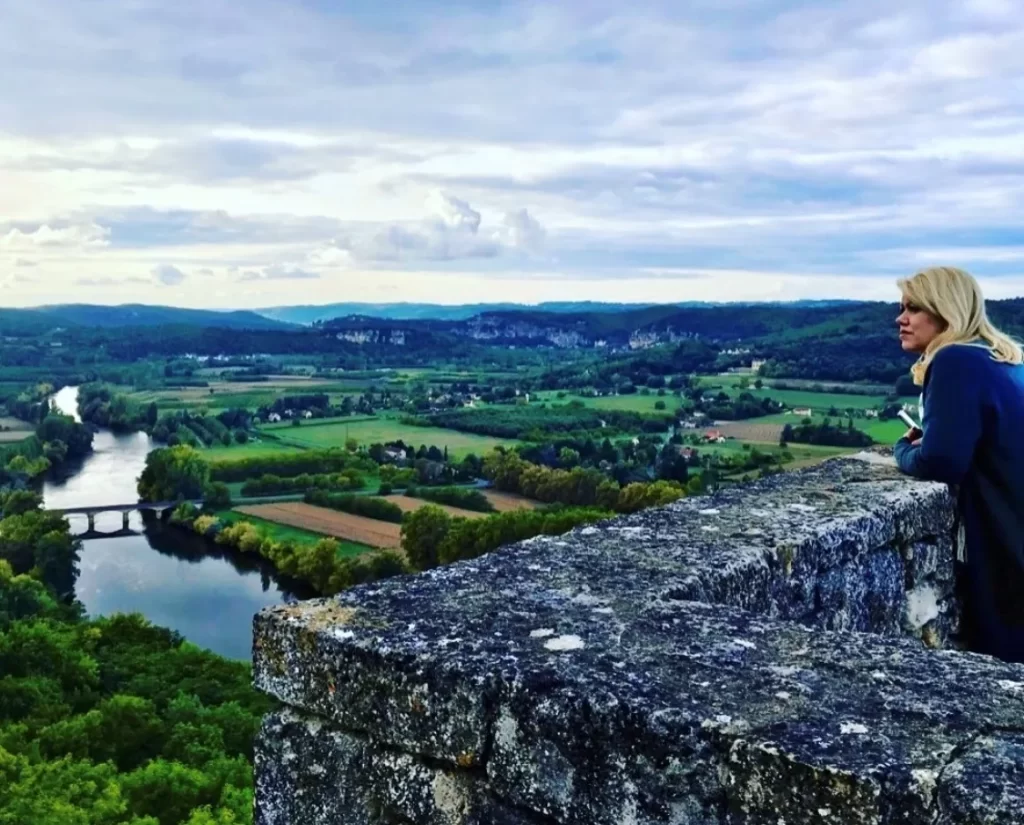The très beaux Dordogne! A stunning view from Domme.
Loulabelle's FrancoFiles episode 34
Other Loulabelles links:
Loulabelles FrancoFiles Instagram
Loulabelles FrancoFiles Spotify Playlist
Loulabelles FrancoFiles Facebook
In 2017 I was fortunate enough to take part in a most amazing and life changing trip on an immersion with my French class at the time. Just recently I chatted to the beautiful Nathalie Foos in Loulabelle’s FrancoFiles episode 32. Nathalie runs A French Journey in Melbourne Australia and organised this incredible immersion together with Rosemary Vine who has also chatted with me on the podcast way back in episode 9. Both are incredible women who I can’t thank enough for the experience!
In this episode of the podcast, you will be guided through the winding roads and petit villages, bringing alive the local rustic-ness of the Dordogne.
This episode will have the most impact listening on one device and accessing Google Earth on another. Or if you’re wonderfully tech-savvy you may be able to access them both at the same time on the same device! Once in each village, pause the podcast chat to get down on the Google Earth ground and have a virtual walking tour around the town, then re-start the podcast to move on!
Plus Beaux Villages de France
There are over 32,000 villages in France and in 1982 the French government created a list to try and promote the petit and picturesque French villages, ones with a quality heritage.
To be designated one of the “Plus Beaux Villages de France”, villages must submit an application form, have an on-site evaluation, and meet certain criteria. At the moment there are about 160 villages on the list, so obviously most villages don’t make the cut which is completely understandable when you consider this criteria:
· there must be some rural character with no more than 2,000 inhabitants
· they must have two national heritage sites
· there must be an on-site evaluation
· the application must have mass support from the town council.
It is claimed that being on the list can bring a rise of between 10-50% in visitor numbers, so clearly being labelled as a Plus Beaux Village is a plus for the tourist dollar, or franc, or Euro these days!
Monpazier
Each time I mentioned to someone that I was going to Monpazier, they tried to correct me and said “oh you mean Montpellier?” Non! I mean MONPAZIER! It’s one of the Plus Beaux Villages de France.
Constructed in 1284 during the 100 years war between the French and English, it is a perfect example of the bastide villages built during that time through all of the region as basically a fortified village with ramparts to protect the town. These villages were built in a very structured way around a central market square which was very different from other medieval villages that were built in a much more haphazard fashion.
Monpazier is in the Coeur de la Dordogne, the heart of the Dordogne, in an area known as the purple Périgord or the Périgord Pourpre so named for all the grapes grown in this region for wine! So as you can imagine there were some exquisite wines tasted during this stay!
Accommodation in Monpazier
Instagram: @dordognevillafrance
Web: www.dordogne-country-house.com
Mes belles amies and I all stayed in Monpazier for the week at Rosemary Vine’s beautiful maison. The villa is about a five minute stroll from the village and overlooks the medieval mastery of Monpazier from the lovely terrace. A gorgeous view for a 5pm aperitif each day!
So whilst staying in Monpazier we explored the village extensively. In the mornings we would wander across to the boulangerie for fresh croissant, and at other times we would enter by walking through the main arch that went through the huge rampart wall at one end of the village just opposite the Mairie or town hall that is outside the old village. There are gorgeous narrow streets with vine covered homes and stores right on the edge. But it was the village square that delighted us in Monpazier. On market day it was a hive of activity, and we could imagine how it has always been the centre of village life in centuries gone by.
Restaurants I recommend in Monpazier
Privilege du Périgord – a rustic but gastronomically delightful family owned restaurant where I had Cuisse de Grenouille or frogs legs for the first time ever!
Restaurant Eleonore – in the divinely traditional salons of the Hotel Edward 1st, on the ramparts of the village of Monpazier. It’s a très beaux building with turrets and a vine covered façade typical of gorgeous chateaux! We had the traditional French 5 courses and virtually rolled out of the place!
La Roque-Gageac
Google Earth La Roque-Gageac link
The village is nestled between a cliff-face and the Dordogne River. It has rows of pretty white and ochre coloured houses facing onto the river and there are many petite ruelles or alley ways leading up the cliff. We enjoyed a seven course lunch at La Belle Etoile Restaurant before going on a traditional boat up the Dordogne.
Domme
After disembarking we drove up to another village on top of the cliff called Domme. Both this village of Domme and the one down below La Roque-Gageac are absolute feats of architecture and engineering. La Roque-Gageac as it is built into the cliff and Domme as it is perched on top. Especially when you consider they were constructed in the 13th century!
Domme is remarkably well preserved with its stone buildings and medieval doors. It was built in its position in order that the villagers could see invaders coming up the river during the 100 years war. The result of this decision is that Domme has a most extraordinary view of the whole of the Dordogne valley.
Rouffignac
A little north east of Domme is a sight I never considered I’d see in France, the prehistoric caves in Rouffignac, La Grotte de Rouffignac. We don’t think of France as being a prehistoric country but there are indigenous cave paintings in this cave that date back more than 150 centuries.
Cadouin
North of Monpazier and almost at the halfway mark between Domme and Bergerac is the exceptionally cute village of Cadouin best known for its medieval abbey, which was built in the flamboyant gothic style. It is an important pilgrimage destination, and once through the door, it is a space of calmness. I recall sitting quietly alone in one corner of the abbey garden and it was quite a lengthy time before I realised I’d better get moving and could be holding up my friends! I felt all the years of history around me and simultaneously that the place was there for me in that moment, for whatever I needed at that time. I didn’t expect to feel such a connection with an abbey built in 1115, but clearly others feel it too as it has been listed as a UNESCO world heritage site.
The rest of Cadouin is delightful. All the buildings are in the gorgeous golden creamy coloured stone with quaint shops and restaurants around a petit square and a few streets running off that. The walkways are narrow and I had to hold myself back from peering into the windows of the homes! The were just so enticing!
There is a well regarded restaurant right across from the abbey, Restaurant L’Abbaye.
Since visiting there, I’ve learned that Cadouin has a medieval festival every year during the second fortnight of August. Apparently many people dress in medieval costume, and the whole place is very festive so I hope to return there at that time of year in the future.
Vézac – Les Jardins de Marqueyssac
Google Earth Jardins de Marqueyssac link
These gardens have been worked on by generations of the same family since 1692 and are exquisite. There are more formalised parts with topiaries and partares, as well as terraces and a part that’s almost wooded with a little train to assist tourists around.
Musique
Joyce Jonathan – Le Bonheur
Recette
So, the food of the Dordogne is what we often think of when we imagine typical regional French food, confit du canard, les truffes (truffles), foies gras and the one I’ll share in this episode:
Omelette aux cèpes (mushroom omelette)



